City guides


New York City Travel Guide
Very few cities can compete with New York's frenetic energy and creativity and the Big Apple remains one of the top urban travel destinations in the world. To visit New York City is to visit one of the most exciting and diverse man-made environments on earth, and travellers never seem to tire of this ever-changing metropolis. New York really is the city that never sleeps and nobody denies that it's endlessly stimulating.
Many arrive on business, but millions more travel on holiday to see the myriad famous sights, trawl the shopping streets, catch a show on Broadway, and soak up the incredible atmosphere. The Statue of Liberty memorably greets travellers just as she once greeted immigrants.
Among the towering skyscrapers, the oasis of Central Park promises some relief from the rat race. The celebrated nightlife beckons party animals, the restaurant scene delights foodies, and the endless supply of museums and galleries charms culture vultures.
Best time to visit New York City
Although the city is a year-round destination, the best time to travel to New York is in autumn, during September and October, when the days are mild and pleasant, without the high humidity of the spring and summer months, or the snow and freezing temperatures that occur in winter.
What to see in New York City
-Watch a show on Broadway, a joy for the whole family.
-Marvel at New York's skyline from the observation deck of the mighty Empire State Building.
-Enjoy all the quirky and iconic fare that the Museum of Modern Art has to offer.
-Pay tribute to the many victims of 9/11 at the World Trade Center.
What to do in New York City
-Wander Greenwich Village, a famously artistic New York neighbourhood.
-Explore the Metropolitan Museum of Art, home to one of the greatest art collections in the world.
-Take a ride on the Staten Island Ferry, one of the best ways to see the city.
-Skate on the scenic Trump Rink in Central Park.
Beyond New York City
Popular excursions include the funfairs of Coney Island, the natural splendour of Bear Mountain State Park, the Dia Art Foundation of Beacon, and the spooky literary joys of Tarrytown, all of which await travellers just beyond the city. The Metro-North Railway can be used to access many nearby towns and cities in New York.
Getting there
John F Kennedy International Airport, one of the world's major air travel hubs, is New York City's main airport, located 12 miles (20km) from downtown Manhattan. New York La Guardia Airport and Newark Liberty International Airport also serve the city.
Did you know?
-New York City is home to about 4,000 street food vendors.
-More than 250 feature films are shot on location in the city annually.
-The musicians who perform in the NYC Subway system go through a competitive audition process.
Things to do in New York City
With New York's countless attractions, it would take months to see and do everything this vibrant city has on offer. The must-see New York attractions include iconic structures and buildings such as the Statue of Liberty, Rockefeller Center, the Empire State Building, Times Square, and the Chrysler Building. In among all the skyscrapers Central Park provides a green haven for relaxation and exercise. Many first-time visitors to New York don't leave Manhattan at all, but the four other boroughs of the city (Bronx, Brooklyn, Queens and Staten Island) all have their own appeal and are worth exploring for those wanting a broader experience of the metropolis. Taking a ride on the Staten Island Ferry is one of the best free activities NYC has to offer.
For culture vultures there are wonderful museums to explore, such as the American Museum of Natural History or the Metropolitan Museum of Art. There are also less high-brow museums: at Madame Tussaud's Wax Museum, for instance, visitors can play superhero on film.
An easy way to see the sights is to take a ride on one of New York's topless tour buses. It may not be as exciting as exploring the city on foot, but it's a great way to learn and see a lot quickly. Central Park also provides a great thoroughfare for sightseers exploring Manhattan on foot, and the grid-pattern layout of the streets makes navigating fairly simple. The New York subway is a good, cheap option for those needing to cover greater distances.
Those planning a lot of sightseeing should consider purchasing the New York Pass, which covers about 100 NYC attractions and allows the holder to skip the often lengthy queues at popular sites.
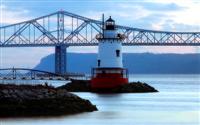
Tarrytown
Known as the setting of Washington Irving's The Legend of Sleepy Hollow, Tarrytown and its surrounds are filled with history. It is the birthplace of the author, home to the impressive Rockefeller residence and sits across the river from Hyde Park, where President Franklin D. Roosevelt was born. The late President's home has a library containing hundreds of photos and artefacts, as well as his car and a letter from Einstein that led to the development of the atomic bomb. Two miles (3km) outside Hyde Park is the Vanderbilt Mansion National Historic Site, a spectacular Beaux Arts mansion.
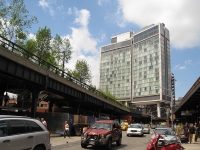
The High Line
The High Line is a verdant elevated strip hovering between the skyscrapers of Manhattan's West Side. Built on what was once a freight rail line, this unique public park brings a welcome splash of greenery into the district. Drawing millions of visitors annually, it has led to a real estate boom in the areas it passes through, with apartments overlooking the pretty strip rocketing in value. The High Line features viewpoints, recreation areas and public spaces for exhibitions and productions. The 14th Street Passage and Chelsea Market Passage are semi-enclosed sections frequently used for public programs and art exhibitions. Picnic spots on the 23rd Street Lawn are ideal for peace and quiet while kids love features such as the Pershing Square Beams, where the original framework of steel beams is exposed to create a garden playground.
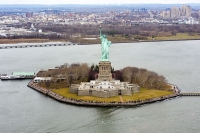
The Statue of Liberty
The universal symbol of freedom, the Statue of Liberty was the first thing seen by 12 million immigrants passing through Ellis Island Immigration Center. Sculpted by Frederic-Auguste Bartholdi and modelled on his mother, the French donated the statue to the US in 1875, and it was unveiled stateside in 1886. The reason was to commemorate the alliance between the two countries during the American Revolution. The ferry calls at both Liberty and Ellis Islands, and tourists can visit the Ellis Island Museum documenting the experiences of the immigrants. On Liberty Island, advance bookings allow visitors to access the crown of the famous statue, but these tickets must be booked some six months in advance for peak summer season.
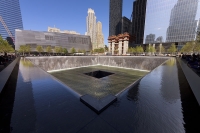
World Trade Center - Ground Zero
The six hectare (16 acre) worksite that emerged from the rubble of the twin towers now symbolises the infamous events on September 11 2001, when almost 3,000 people lost their lives. Millions now come to pay tribute and witness the devastation at viewing sites. In January 2004, a design named Reflecting Absence by Michael Arad and Peter Walker was unveiled for the World Trade Center Memorial. The memorial features a landscaped civic plaza with two massive voids aligned with the footprints where the twin towers once stood. The memorial and museum are now open to the public, providing an accurate and moving account of what the community endured during the attacks. Tourists should be mindful that this is a sombre memorial frequented by mourning family members, so loud chatter and smiling selfies are inappropriate.
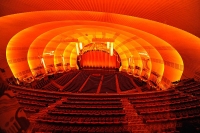
Radio City Music Hall
Located in Rockefeller Center, Radio City Music Hall is one of the most famous theatres in the world. The home of the famous Rockettes chorus line, the interior of the theatre was declared a New York landmark in 1978. While not in regular use anymore, the Hall's beautiful cinema still hosts premieres, shows and selected feature films. The most popular event is the annual Radio City Music Hall Christmas Spectacular, attracting more than a million people and running since 1933. It's best to check the official website listings to see which potential productions and acts are on while tours run daily and usually receive rave reviews.
Empire State Building
The Empire State Building in New York is an iconic landmark in the sprawling Manhattan cityscape. Completed in 1931, it stretches 102 storeys into the sky and was considered the tallest building between 1931 and 1970. Today, it is only the 28th-tallest building in the world yet still retains much of its dramatic grandeur and presence. One of the most beloved activities is embarking on the journey to the top floor's observation deck, providing views across the entire city. It's best to visit between 8am and 11am, avoiding the scores of daily visitors. Free multimedia tours are downloaded with every admission.
Central Park
The founders of New York set aside 340 hectares (840 acres) of central Manhattan as a public space, with Central Park officially opening in 1876 to provide an essential green lung within the concrete jungle of New York. It contains themed gardens, tennis courts, lakes and even a small zoo, infused with daily joggers, skaters, buskers and tourists. But there are areas beyond the range of baseballs and frisbees where tranquillity can be found, with music concerts and Shakespearian plays frequent occurrences. During winter, two ice-skating rinks open up in Central Park, with the Wollman Rink in particular considered one of the most picturesque in the world.
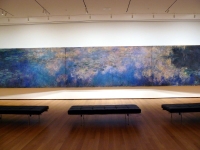
Museum of Modern Art
Founded in 1929, the Museum of Modern Art owns the most important collection of modern art in the United States. Referred to as MoMA, artists with work on display include greats such as Monet, Van Gogh, Matisse, Picasso, Max Beckman, Ansel Adams and Kiki Smith. What started as a gift of eight prints and a drawing developed into a vast and varied collection of some 150,000 paintings, prints, sculptures, photographs, and other media. MoMA's Library and Archives boast an impressive collection of books, historical documents and photographs. Priding itself as an educational institution, the Museum of Modern Art offers various activities and programmes for the general public. In addition, special segments broaden the community knowledge of and approach towards the exciting and puzzling world of modern art.
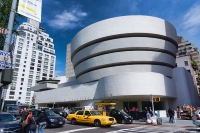
The Guggenheim Museum
Designed by renowned US architect Frank Lloyd Wright, the Guggenheim was built in 1959 and is an icon of Modernist architecture specifically created to showcase the modern art within. It features a highly celebrated collection of late 19th and 20th-century artworks, as well as touring exhibitions. Beneath a glass dome, a quarter mile ramp spirals down the inside of the building, past a collection including pieces by Pissarro, Kandinsky, Klee, Picasso, Toulouse-Lautrec, Cézanne, Mapplethorpe and Gober.
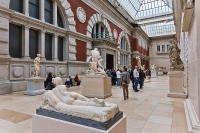
Metropolitan Museum of Art
The Metropolitan Museum, affectionately known as the Met, possesses one of the greatest and largest art collections in the world. Banners above the Met's Fifth Avenue entrance herald the current attractions at this cherished New York institution. There are always temporary exhibitions from around the world alongside the impressive permanent collection. Highlights are numerous, with American collectors having the foresight and cash to buy up a large number of Impressionist and Post-Impressionist masterpieces from Europe at the end of the 19th century. The art collection at the Met now contains more than two million works of art from across the planet, from ancient worlds through to modern times. Some notable works are present from such greats as Van Gogh, Renoir, Monet, and Cezanne, rivalling any art collection on earth.
American Museum of Natural History
Challenged only by its counterpart in London, the American Museum of Natural History is the largest and most important museum of its kind in the world. Forty five exhibition halls hold more than 30 million artefacts, quite enough to keep anyone busy on a rainy afternoon. The most popular exhibit is a 50ft (15m) tall skeleton of a barosaurus in the Theodore Roosevelt Rotunda, and there are three more spectacular dinosaur halls on the fourth floor. Other halls include the Hall of Biodiversity, the Hall of Ocean Life, and the Hall of Human Biology and Evolution. The fabulous Hayden Planetarium is a 90ft (27m) wide aluminium sphere that seems to float inside a massive glass cube, which in turn is home to the Rose Center for Earth and Space. Those tired of walking can check out the Museum of Television and Radio.
Long Island
Long Island extends 100 miles (161km) east of New York City into the Atlantic Ocean and is a popular weekend destination for New Yorkers and tourists. The glorious white, sandy beaches along the south shore are ideal for those seeking refuge from the sweltering city in the summer.
Jones Beach is a 6 mile (10km) stretch of coastline, with thousands of people converging to soak up the sun. Fire Island is the east coast's leading gay resort, accessible via a short ferry ride, while cliffs crown stately homes and luxurious mansions along the exclusive beaches of the north shore.
The Hamptons is a community in the far east of New York, its miles of pristine beaches attracting the rich and famous from all over the United States. The heart of its scene is East Hampton, which as some excellent shops, restaurants, and a lively nightlife.
In Long Island's North Fork, around the town of Cutchogue, are the winelands of New York. Of the 13 vineyards, the best known is Pindar, which has tours and tastings every day. Nearby, the pretty, 17th-century town of Orient offers white clapboard houses and unspoilt beaches.
There are hundreds of museums, attractions, and sporting facilities scattered around Long Island to suit all tastes. Buses depart for Long Island regularly each day, although the quickest way to get there is via the Long Island Railroad from Penn Station. If driving, visitors should head east on the Long Island Expressway from Manhattan.

Hudson Valley and the Catskills
Just north of New York City, the Hudson Valley is surprisingly rural and littered with charming towns, picturesque farms, and old mansions. Many New Yorkers head this way at the weekend, attracted by the slower pace of life and scenic drives.
Albany, the region's capital, was founded by Dutch fur trappers in the 17th century and made its money by controlling trade along the Erie Canal. There is not a great deal to do or see in Albany when it comes to traditional cultural sightseeing, but sights include the New York State Museum and the Albany Institute of History and Art.
The beautiful Catskills Mountains, northwest of New York City, has long been a popular vacation spot and the choice of many a wealthy New Yorker for their summer home. The region is dotted with picturesque towns, reservoirs, forests, parks, historic buildings, and plenty of resorts.
Nicknamed the Borscht Belt, from the 1940s to the 1960s, the Catskills was highly popular with Jewish New Yorkers in particular, and some of the finest Jewish comedians sprang from the area, including Woody Allen, Mel Brooks, and Joan Rivers.
The region is also famous for hosting one of the world's best-known entertainment events, the 1969 Woodstock Festival. Over 500,000 free spirits gathered on Max Yasgur's dairy farm in Bethel to see some of the finest musicians of the era.
Today, the site is open to the public as is a museum that houses archives and interesting information from the event. The Catskills also offer plenty of exciting outdoor activities, including hunting, fly-fishing, skiing, canoeing, hiking, camping, and even golf.
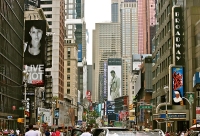
Broadway
Going to the theatre is one of the most popular tourist events in New York and the shows on Broadway are world famous, boasting some of the best productions in the world from blockbuster musicals to intense and intimate dramas. There are ongoing shows that have been running for years, such as The Lion King, Phantom of the Opera, Chicago, and A Chorus Line. Newer, edgier shows play off-Broadway, and may provide just as much entertainment at slightly lower prices. This is one way to experience part of the American dream, even if only on holiday. There is something to entertain people of all ages.
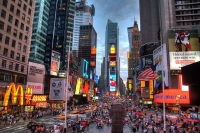
Times Square
Though it is ultimately just an intersection at the corner of Broadway and 42nd Street, Times Square has achieved iconic status. In a single frame, it successfully represents the hive of activity that is New York City. Flashing advertisements produce a mesmerising and memorable sight, and account for why Times Square is used in countless films, TV series and books, and is the base for ABC's Good Morning America programs. Thousands gather annually for New Year's Eve in the square to see the famous ball drop. Since 2009, Times Square has been closed to traffic and visitors can now enjoy strolling and sitting at their leisure, instead of worrying about the city's notorious taxis and bustling vehicles.
Rockefeller Centre
This 22 acre (8ha) land houses a plethora of iconic New York City attractions. Radio City Music Hall ranks highly among visitors, having hosted multiple awards shows such as the Grammys, Emmys and MTV Music Awards and also being a concert venue frequented by today's top performers. The Rockefeller Plaza is the site of the eerie Lunchtime atop a Skyscraper photograph, as well as being the home of Saturday Night Live and popular TV series 30 Rock. The Rockefeller Center also claims to have the best views of the city, a hotly contested competition for sure. At the building's base is the Rink at Rockefeller Center, with the golden statue of Prometheus at its head. Beneath is the concourse, an underground pedestrian mall boasting designer brands and food outlets.
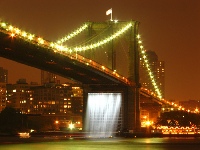
Brooklyn Bridge
The sheer scope of New York City is hard for visitors to understand until they've traversed the Brooklyn Bridge. Completed in 1883, it crosses 5,989 feet (1,825 m) of the East River and connects two of New York's biggest metropoles, Manhattan and Brooklyn. The construction was an impressive feat of engineering ingenuity and, upon completion, it was the longest suspension bridge in the world. Today, it is a treasured landmark of the city, colourfully illuminated at night to highlight the architectural towers and hangings. There is a pedestrian walkway from which visitors can savour vistas of both Manhattan and Brooklyn. Photographers looking for quintessential New York cityscapes should be sure to walk the bridge.
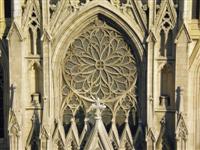
St Patrick's Cathedral
St Patrick's Cathedral is a magnificent example of Gothic architecture popular in 13th-century Europe. One of the city's most gorgeous buildings, its spires soar 330 feet (100m) into the air while its entrance is both grand and ornate. Built between 1850 and 1878, it is now the seat of the archbishop of New York and the largest catholic cathedral in the United States. To most New Yorkers and harried tourists, St Patrick's is most valued for its peace and tranquillity. But it's still an active place of worship although tourists are welcome they should show respect, especially during church services. Guided tours are available.
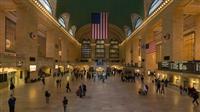
Grand Central Station
One of New York's most famous and best loved landmarks, Grand Central was opened in 1913 opposite Rockefeller Center. It is one of the world's largest train stations, with 44 platforms, but its true distinction is its magnificent architecture. Its striking ambiance is anchored by enormous windows and the refurbished ceiling covered by a detailed astronomical fresco. The terminal houses a number of good restaurants, budget-friendly eateries and speciality shops. The magnificent Vanderbilt Hall regularly houses public events, while there is also a one-hour guided tour; visitors should book several weeks ahead in peak season to avoid disappointment. Interestingly, Grand Central sees about double the amount of visitors every day as it does commuters.
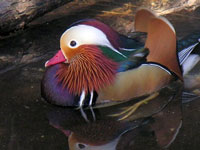
Central Park Zoo
Home to some exotic and beautiful animals, the Central Park Zoo is a must for all children and animal lovers visiting the city. Residents at the zoo include the elusive red pandas, polar pears, snow leopards, and snow monkeys to name a few. The Tisch Children's Zoo is a great place for the young, with children able to pet the goats, sheep, alpacas, potbellied pigs, and other barnyard animals on display. Booking online may result in discounts and also allows visitors to skip the long summer queues.
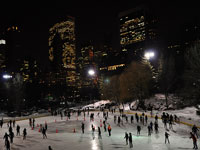
Wollman Rink
The Wollman Rink, located in Central Park and made famous by many movies, is a fantastic place to take the kids for the day during the winter months in New York City. The setting of this ice rink is beautiful, surrounded by trees with the New York City skyline above them. Children can even attend skating school while adults can host a party or event, guaranteeing an unforgettable experience. The rink is not just for children but also a popular spot for dates in New York City due to the romantic associations and stunning setting.
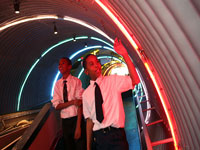
Brooklyn Children's Museum
The Brooklyn Children's Museum is a great place to take the little ones while on holiday in New York City. It was founded in 1899 and its collections and exhibits include hands-on activities, role-playing opportunities, and resident animals. Thousands of artefacts are on display to teach children about science, the environment, culture, and the arts. There are no 'Do Not Touch' signs here! There is a cafe and a shop at the museum, and a special 'Totally Tots' section for kids under five. Adults must accompany children.
The Frick Collection
The Frick is quite possibly New York's most underrated art gallery, a collection of exceptional paintings featuring important works by Vermeer, Manet, Rembrandt, Whistler, Goya and Van Dyk. A highlight is the renowned pair of Holbein paintings of Thomas More and Thomas Cromwell, and a group of small bronze sculptures rated as some of the finest in the world. This was the New York residence of Henry Clay Frick, who transformed a fortune made in the coal business into this sublime building facing onto Central Park. The interior courtyard is a tranquil retreat from the busy world outside.
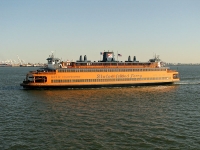
Staten Island Ferry
The ferry from Battery Park to Staten Island and back is a great way to see the Lower Manhattan skyline and Hudson River life. It's a must-see New York attraction that doesn't cost a thing. It also skirts the Statue of Liberty, affording decent views of this iconic structure. Most tourists stay onboard for the return leg, but it's worth hopping off and exploring a bit of Staten Island. Staten Island is a borough of New York City and a fun neighbourhood to explore, but the ferry journey, mainly used by commuters, is actually the main attraction. The ferry leaves roughly every 30 minutes or every hour and takes 25 minutes each way. Schedules are available on the official website.
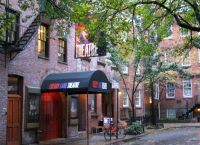
Greenwich Village
Greenwich Village began life as an industrial park but has been transformed by a vibrants arts community. Affectionately known as the Village, it's now home to New York University, the famous Washington Square Park and also the setting for the iconic sitcom Friends. Despite gentrification, the district has retained a bit of its artistic flair. There are a number of great off-Broadway theatres, as well as historic jazz and rock venues such as Bitter End, Village Vanguard, Small's, and the Blue Note. Additionally, there's an eclectic mix of international restaurants and cafes.
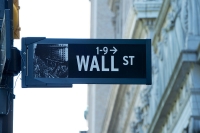
Wall Street
Home to the New York Stock Exchange, Wall Street has attained legendary status as the financial heart of the USA. The narrow street runs from Broadway to the East River and is home to landmarks such as Federal Hall, where George Washington was inaugurated as the first president. Twenty-three Wall Street still has shrapnel holes in its limestone facade from the 1920 Wall Street Bombing. Perhaps the most iconic symbol of Wall Street is the Wall Street Bull, a 7,100 pound (3,200kg) bronze sculpture by Arturo Di Modica. The sculpture is a popular photo opportunity in New York, symbolising financial optimism and prosperity. The installation of Fearless Girl, a small statue of a girl facing the beast, adds another layer of artistic intrigue. The statue was done by Kristen Visbal.
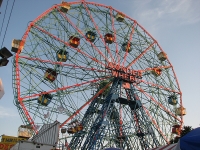
Coney Island
Coney Island has been a tourist attraction in New York City since the 1830s, when New Yorkers would flock to the beaches. Its movie theatres, amusement parks, museums, circus, aquarium and restaurants still attract crowds each summer. Claiming to be the birthplace of the hotdog, a visit to Coney Island isn't complete without sampling the yummy street food along the boardwalk. While filling their stomachs, visitors can gaze upon the fireworks that light up the sky each Friday around 9.30pm. The activities and amusements at Coney Island are in full swing from May to September, but many attractions close outside these months.
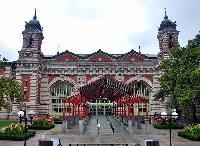
Ellis Island
From 1892 to 1924, more than 20 million immigrants moved through the crowded halls of Ellis Island. Today, it draws millions of people each year as one of the most popular tourist attractions in New York City. The Ellis Island Immigration Museum offers multimedia exhibits and audio tours, a chance to experience the island as a new arrival might have back in the day. One of the more popular exhibits is the American Family Immigration Center, where visitors can access passenger records to find relatives, while there are also special children's tours. Reached by ferry, the journey also stops at the iconic Statue of Liberty.
Things to do with kids in New York City
New York is a great place for holidays with children. Parents can take the family out to Ellis Island to see the Statue of Liberty or trek up the Empire State Building to stand on its observation deck, the panoramic views of the metropolis a joy at any age.
For active children, a stroll through Central Park will give them plenty of space to stretch their legs and, in winter months, families shouldn't miss ice skating at the Trump Wollman Rink or Rockefeller Plaza. The amazing shops around New York City are also perfect for those rainy days.
Options include NIKETOWN and the decadent Dylan's Candy Bar, where kids will go wild at the amount of sugary candies and chocolates available. The Brooklyn Children's Museum is also worth a visit, as are the New York Aquarium and Central Park Zoo.
For warm summer nights, nothing beats a baseball game at Yankee Stadium, complete with hot dogs and popcorn. With so much to see, children visiting New York City will be sure to have a memorable and unforgettable experience.
American Museum of Natural History
Challenged only by its counterpart in London, the American Museum of Natural History is the largest and most important museum of its kind in the world. Forty five exhibition halls hold more than 30 million artefacts, quite enough to keep anyone busy on a rainy afternoon. The most popular exhibit is a 50ft (15m) tall skeleton of a barosaurus in the Theodore Roosevelt Rotunda, and there are three more spectacular dinosaur halls on the fourth floor. Other halls include the Hall of Biodiversity, the Hall of Ocean Life, and the Hall of Human Biology and Evolution. The fabulous Hayden Planetarium is a 90ft (27m) wide aluminium sphere that seems to float inside a massive glass cube, which in turn is home to the Rose Center for Earth and Space. Those tired of walking can check out the Museum of Television and Radio.

Central Park Zoo
Home to some exotic and beautiful animals, the Central Park Zoo is a must for all children and animal lovers visiting the city. Residents at the zoo include the elusive red pandas, polar pears, snow leopards, and snow monkeys to name a few. The Tisch Children's Zoo is a great place for the young, with children able to pet the goats, sheep, alpacas, potbellied pigs, and other barnyard animals on display. Booking online may result in discounts and also allows visitors to skip the long summer queues.

Wollman Rink
The Wollman Rink, located in Central Park and made famous by many movies, is a fantastic place to take the kids for the day during the winter months in New York City. The setting of this ice rink is beautiful, surrounded by trees with the New York City skyline above them. Children can even attend skating school while adults can host a party or event, guaranteeing an unforgettable experience. The rink is not just for children but also a popular spot for dates in New York City due to the romantic associations and stunning setting.

Brooklyn Children's Museum
The Brooklyn Children's Museum is a great place to take the little ones while on holiday in New York City. It was founded in 1899 and its collections and exhibits include hands-on activities, role-playing opportunities, and resident animals. Thousands of artefacts are on display to teach children about science, the environment, culture, and the arts. There are no 'Do Not Touch' signs here! There is a cafe and a shop at the museum, and a special 'Totally Tots' section for kids under five. Adults must accompany children.
Eating Out
New York City is famous for roadside vendors selling all-American goodness, such as hotdogs, corndogs, bagels, and donuts. But it's an international affair when dining out, with offerings of cuisine from all over the world meaning it would take a lifetime to sample them all.
With more than eight thousand restaurants to choose from, it is difficult to know where to begin. Chinatown has restaurants serving Cantonese, Sichuan, and Shanghai cuisine, while there are also a few Chinese restaurants where dim sum is available throughout the day.
The popular Times Square is plagued with mediocre chain restaurants but there are a few wonderful eateries beyond the tourist traps. New York's steakhouses offer a variety of delicious steak options from porterhouse steak to New York strip steak.
Everything is big in the United States and the pizzas and pizza pies are no different. With plenty of fantastic pizza and Italian restaurants around the city, it's a pizza lover's paradise. Many small pizzerias sell the iconic New York-style pizza.
Ukrainian, Indian, and Japanese cuisine can be found in the East Village, while Harlem is synonymous with African and Soul food. Queens has the most variety, with Greek, Irish, Latin American, Russian, Indian, and Kosher fare on offer to tantalise the taste buds.
Shopping
The amount and calibre of stores in the city will blow visitors away. Offering some of the best and most expensive shopping in the world, 5th Avenue is synonymous with classy high-end department stores such as Bergdorf's and Saks. Madison Avenue is known as the trendy road, boasting 15 blocks of celebrity designer shops such as Chanel, Jimmy Choo, and Prada. Soho is one of New York's poshest outdoor malls, with cobblestone streets and loft-like spaces creating a pretty and unique shopping experience.
As cosmopolitan as New York may be, visitors on a tighter budget can still find plenty of bargains at the city's flea markets, which offer some top quality goods with stores touting designer knockoffs, antiques, jewellery, curios, thrift wear, home furnishings, and cosmetics. Chinatown is a budget shopper's paradise with cheap knockoffs on offer, and haggling common practice.
Whether shopping in upscale Madison Avenue or the bargain-friendly Lower East Side, New York has something to offer everyone. Souvenirs can often be tacky, including miniature Statues of Liberty, I (heart) NY gear, New York Yankees merchandise, and Broadway posters.
Nightlife
The nightlife in New York City encompasses jazz bars, nightclubs, lounges, comedy clubs, and live shows, with something happening around every corner. The Village, Broadway, Bowery, and Madison Square Garden are just a few destinations for evening entertainment in New York.
As a hub of the jazz world, New York is home to venues such as 55 Bar and Arthur's Tavern. Jazz tours from Greenwich Village to Harlem are a fun option for enthusiasts, with a stop at the legendary Apollo Theatre a great attraction to tick off the bucketlist.
As the launching pad of big name comedians such as Jerry Seinfeld, New York also has many comedy shows, with some of the best happening at the New York Comedy Club.
Of course, there are always famous Broadway shows in New York. Visitors should try the Palace or Eugene O'Neill theatres for the latest productions. Broadway shows are expensive, hence the popularity of the three TKTS discount ticket booths, the most popular of which is in Times Square.
They open every day at 11am, but the queues form well before this. Travellers can pick up last-minute tickets for half of the regular price, depending on what's available. There's seldom a queue at 5pm, with last minute prices dropping even further.
Nightclubs come and go quickly in New York City, as the fickle population becomes enamoured with the newest venues and trends. But visitors can always rest assured that whatever they want, the City of Dreams will have plenty of it.
Live music venues covering hip hop, rock, indie, and almost any other genre imaginable abound, and well-established venues offer events such as poetry readings. At any given time, internationally acclaimed DJs are usually heating up dancefloors in the New York darkness.
World-class performing arts venues are a dime a dozen in a city that boasts Madison Square Garden, Radio City Music Hall, Lincoln Centre, and Carnegie Hall, and visitors can take their pick of ballet, opera, symphony orchestras, and chamber music.
Getting Around
New York's public transport system is relatively good and cheap, and it includes buses and the subway. There are also the iconic and ever-present yellow cabs, although they are more expensive. Visitors should avoid unlicensed cabs, sometimes called gypsy or pirate cabs. Lyft and Uber are available.
Visitors can use a combination of these or just get around on foot. Walking is often the best way to see the city. During rush hours, when buses and taxis are caught in gridlock and the subway is overcrowded, stretching the legs can be the quickest option.
Usually, the most efficient way to get around is the 24-hour underground system, especially as most of Manhattan's sights are near subway stations. Like other massive cities, however, this can be extremely confusing at first.
The bus system is simpler but slower, a good option for shorter distances or for travelling across town. Driving in New York is not recommended as traffic is heavy, drivers rude and aggressive, and parking both rare and exorbitant.
New York City Climate and Weather
New York City has a humid subtropical climate, with cold winters and hot, moist summers. The city's coastal location ensures that winters (December to February) are not as cold as inland cities on the same latitude, and daytime temperatures generally stay above freezing point but average lows drop to 27F (-3C). Snow is common in winter, but the amount varies, and winter rain is common. Spring in New York is pleasantly warm, and the weather heats up to high temperatures of around 77F (25C) by mid-May. Summers (June to August) are generally swelteringly hot and humid, with average highs hitting 84F (29C). The best time to travel to New York is in autumn, when temperatures are mild, days are sunny and humidity not too high.
United States of America travel info
Electricity
The electrical current is 120 volts, 60Hz. Plugs are mainly the type with two flat pins, though three-pin plugs (two flat parallel pins and a rounded pin) are also widely used. European appliances without dual-voltage capabilities will require an adapter.
Language
English is the most common language spoken but Spanish is often heard in the south-western states.
Money
The official currency is the US Dollar (USD), which is divided into 100 cents. Only major banks exchange foreign currency. ATMs are widespread and credit cards are widely accepted; Apple Pay and Google Pay are very popular. Banking hours are Monday to Friday 9am to 3pm.
Tipping
A 15 percent tip is expected by taxi drivers, bartenders, hairdressers and waiters, but travellers shouldn't tip in fast-food or self-service restaurants. In expensive restaurants or for large parties, the tip should be 20 percent of the bill. It's normal to tip staff such as valets and porters in hotels; this is discretionary, although a minimum of $5 is expected. Most services are customarily tipped if the service is good.
Health
There are no specific health risks associated with travel within the USA. Medical facilities are excellent, but expensive. Only emergencies are treated without prior payment and treatment can be refused without evidence of insurance or proof of funds. Good medical insurance is essential.
Safety
Travel within the United States is generally trouble-free, though travellers should be aware that the US shares with the rest of the world an increased threat from terrorist incidents. Security has been heightened, particularly at airports. Restrictions on hand luggage apply and travellers are advised to check on the latest situation with airlines in advance. Travellers should also be alert to the dangers of car and street crime in cities and should use common sense and take basic precautions. Hurricanes are common between June and November, putting the southern USA, including the Gulf Coast and the eastern US at risk. There's a risk of wildfires in many dry areas in the US, particularly on the West Coast from March to November.
Local customs
Laws vary from state to state, including speed limit, fines and punishment. The age at which alcohol may be legally bought and consumed is 21 years.
Doing business
In such a large country, filled with so many diverse groups, business practices may differ according to each state, though rarely to any large degree. The East Coast is traditionally more formal than the West Coast, though in states such as California, dress code and conservative appearance are as common as they would be in New York. Punctuality is important throughout the country and it's considered rude to be late for a meeting. Gift-giving is uncommon as it may be construed as bribery. Appropriate titles (Mr, Mrs, Ms) are used upon introduction and until otherwise stated. Americans favour politeness and greetings of 'Hello' and 'How are you?' are often expressed with sincerity. Business hours may vary in each state, but an 8am start and 5pm finish Monday to Friday is the most common with an hour over lunch.
Status and age are not necessarily indicative of seniority, nor do they carry much weight in themselves. Those doing business in the States should be mindful of this fact; foreigners should never make assumptions about someone's position or rank. Best practice is to be respectful to all parties. That said, the US upholds a hierarchal business structure in which 'the boss' is the ultimate decision-maker. Senior leaders have the power of the last word, and can go against the grain just as easily as they can follow popular opinion. Foreigners should concentrate on winning over this individual, even if the greater group seems unsupportive. Americans value a direct style of communication. In this fast-paced, consumer culture 'time is money', and small-talk is viewed as unnecessary and wasteful. It's best for foreigners to get to the point quickly, speak about issues in a frank and open manner, and to avoid taking offence if someone questions or challenges them outright.
Duty free
Travellers to the United States who are returning residents of the country do not have to pay duty on articles purchased abroad to the value of $800 provided their stay was longer than 48 hours and their duty-free allowance was not used in the 30-day period prior. For passengers arriving from Samoa, Guam and the U.S. Virgin Islands, a duty-free allowance of $1,600 is allowed. The following items are included in this: 50 cigarettes and 10 cigars and 150 millilitres (5 fl. oz.) of alcoholic beverages or 150 millilitres (5 fl. oz.) of perfume containing alcohol. Restrictions may apply to goods from Cuba, Iran, North Korea, Burma (Myanmar), Angola, Liberia and Sudan. It is prohibited to import Cuban cigars from any country.
Travellers to the United States who are non-residents do not have to pay duty on the following items: 50 cigars or 200 cigarettes and gifts to the value of $100 provided their stay in the USA is not less than 72 hours and that the allowance has not been used in the preceding six-month period.
Prohibited items for residents and non-residents include meat or meat products, poultry, narcotics, absinthe, plants, seeds, vegetables, fruits, soil, live insects and other living plants or animal pests. Fish is prohibited unless it carries disease-free certification. Wildlife and animals or their by-products carry restrictions. Dairy products and eggs from specified countries are not allowed. Firearms and ammunition are not allowed without the necessary license and permit.
Communications
The international country dialling code for the United States is +1. Mobile networks cover most of the country, especially all urban areas; travellers can purchase local prepaid SIM cards for unlocked phones or use eSIMs if their cellular providers support it on their networks. WiFi is widely available.
Passport & Visa
It is highly recommended that travellers' passports have at least six months' validity remaining after the intended date of departure from them travel destination. A visa is required for short visits unless travellers qualify for entry under the Visa Waiver Program.
The Visa Waiver Program (VWP) enables citizens of certain countries to travel to the US for a stay of up to 90 days without a visa. Visitors under the VWP need a valid Electronic System for Travel Authorization (ESTA), which allows the US government to screen all visitors before travel. Visitors entering the country under the VWP must have a machine-readable passport (MRP) that has a barcode on the photo page. Travellers under the VWP must have passports that include biometrics if they wish to enter the country without a visa, which means that passports must contain unique personal data such as fingerprints or iris details. All passports must contain a digital photo image in order to travel visa-free. All visitors to the USA have a photograph and two fingerprints taken by an inkless scanner on arrival, including those travelling visa-free under the VWP.
As part of the Western Hemisphere Travel Initiative (WHTI), all travellers travelling between the United States and Canada, Mexico, Bermuda, and the Caribbean region are required to present a passport or other valid travel document to enter or re-enter the United States. If departing from the USA, a valid passport is required by immigration authorities. Immigration officials often apply different rules to those stated by travel agents and official sources.
Entry requirements
US citizens require passports.
UK nationals require a passport valid for duration of stay. Most passport holders can get an Electronic System for Travel Authorisation (ESTA) through the Visa Waiver Programme, which allows travel to the US for up to 90 days. The VWP includes tourism, certain types of business visit and transit to another country.
The most important requirement on entering the U.S. is providing proof of Canadian citizenship. A valid Canadian passport is the best document to prove Canadian citizenship and the right to return to Canada. However, several other documents can serve, depending on the mode of transport. Generally, Canadian citizens do not require visitor, business, transit or other visas to enter the United States from Canada, though there are some exceptions.
Passports must be valid for the period of intended stay. If visiting the US for fewer than 90 days, Australian nationals may be eligible to apply for an Electronic System for Travel Authorization (ESTA), and enter under the Visa Waiver Program (VWP).
South Africans must hold a passport valid for duration of stay. A visa is required.
Passports must be valid for duration of stay. Irish nationals can get an Electronic System for Travel Authorisation (ESTA) under the Visa Waiver Programme for entry into the United States.
Passports must be valid for duration of stay. New Zealand nationals can get an Electronic System for Travel Authorisation (ESTA) under the Visa Waiver Programme for entry into the United States.
Useful contacts
United States Tourist Office: www.usatourist.com
911 (General)Embassies / consulates in other countries
United States Embassy, London, United Kingdom: +44 20 7499 9000.
United States Embassy, Ottawa, Canada: +1 613 688 5335.
United States Embassy, Canberra, Australia: +61 2 6214 5600.
United States Embassy, Pretoria, South Africa: +27 12 431 4000.
United States Embassy, Dublin, Ireland: +353 1 668 8777.
United States Embassy, Wellington, New Zealand: +64 4 462 6000.
Embassies / consulates in United States of America
British Embassy, Washington DC: +1 202 588 6500.
Canadian Embassy, Washington DC: +1 202 682 1740.
Australian Embassy, Washington DC: +1 202 797 3000.
South African Embassy, Washington DC: +1 202 232 4400.
Irish Embassy, Washington DC: +1 202 462 3939.
New Zealand Embassy, Washington DC: +1 202 328 4800.


